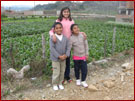
|
|
About Nepal Nepal is a beautiful country. Noted for its majestic Himalaya, which
in Sanskrit means the abode of snow, Nepal is very mountainous and hilly.
It is home to 8 of the world's 10 tallest mountains including the biggest:
Everest. For a small country, Nepal has great physical diversity, ranging from
the Tarai Plain at about 300 meters above sea level in the south to the
almost 8,800-meter-high Mount Everest (Sagarmatha in Nepali), in the north.
From the lowland Terai belt, the land rises in successive hill and mountain
ranges, including the stupendous rampart of the towering Himalayas, ultimately
reaching the Tibetan Plateau beyond the Inner Himalayas. This rise in
elevation is punctuated by valleys situated between mountain ranges. Within
this maze of mountains, hills, ridges, and low valleys, there is a resulting
enormous diversity of ecology, flora, fauna and landscapes. Apparently
Nepal has over 850 species of birds alone - more than the whole of the
north American continent!
|




 Nepal
is divided into three areas: the Mountain Region, the Hilly Region, and
the Tarai Region. All three are parallel to each other, from east to west,
,occasionally bisected by the country's river systems. These ecological
regions were divided by the government into development sectors within
the framework of regional development planning.
Nepal
is divided into three areas: the Mountain Region, the Hilly Region, and
the Tarai Region. All three are parallel to each other, from east to west,
,occasionally bisected by the country's river systems. These ecological
regions were divided by the government into development sectors within
the framework of regional development planning. 